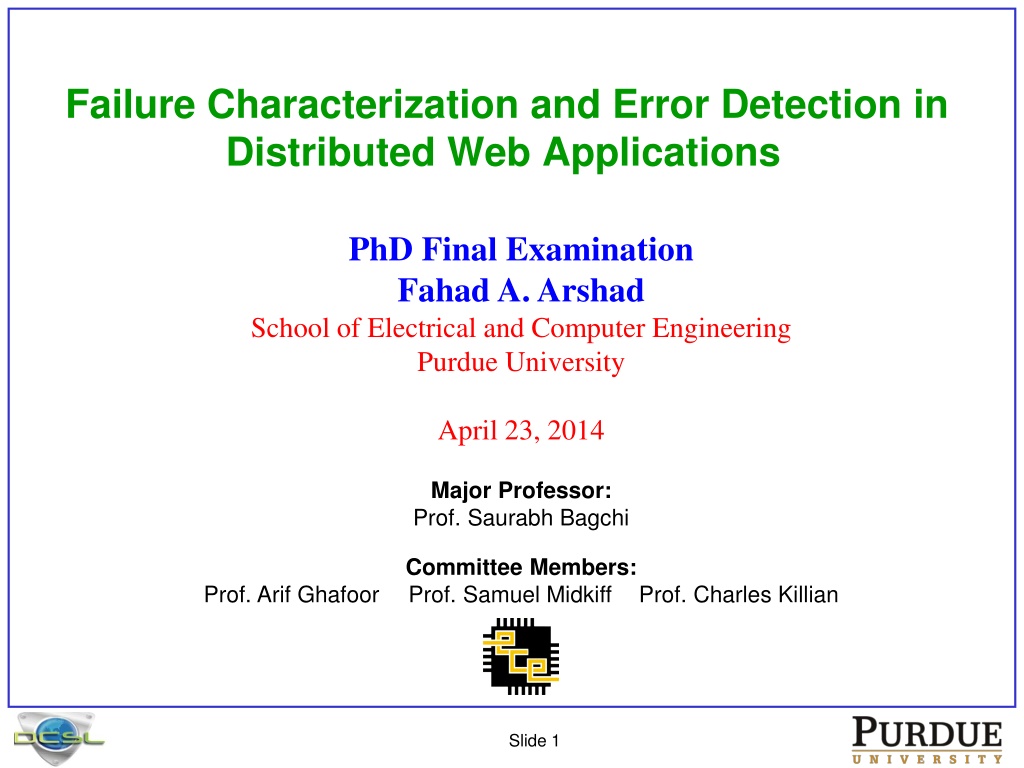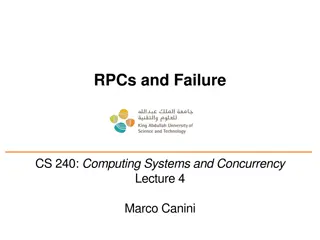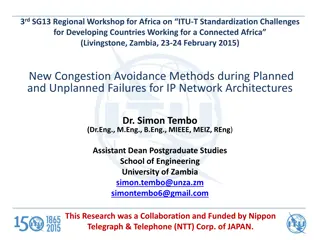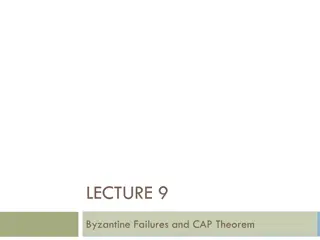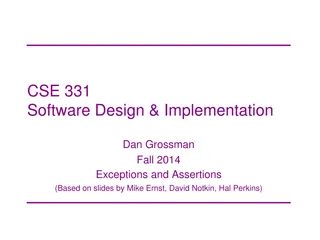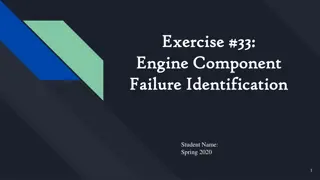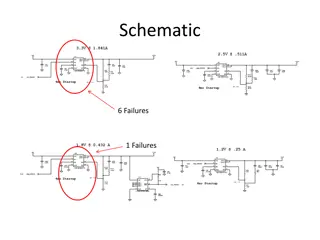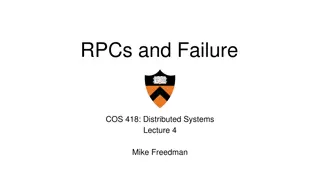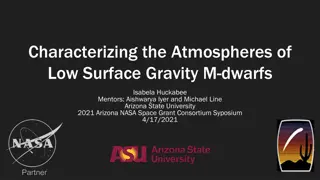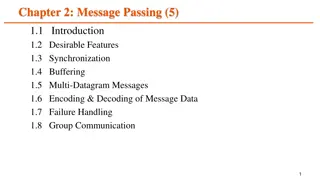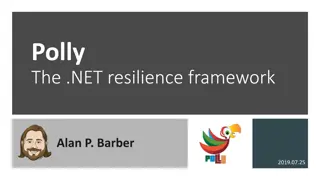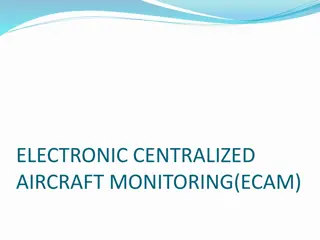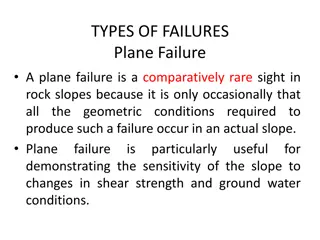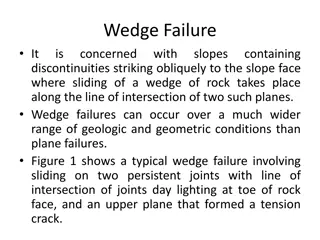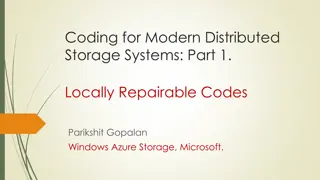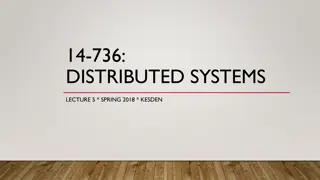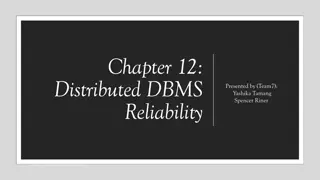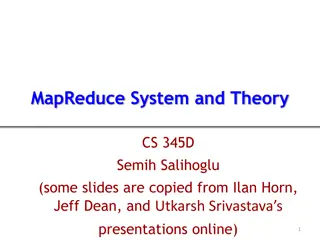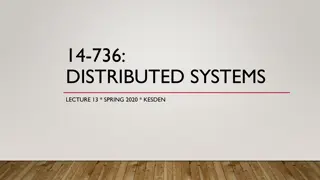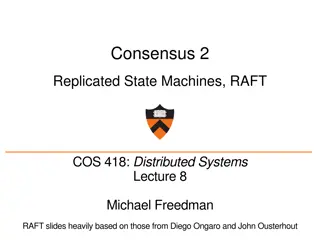Challenges in Detecting and Characterizing Failures in Distributed Web Applications
The final examination presented by Fahad A. Arshad at Purdue University in 2014 delves into the complexities of failure characterization and error detection in distributed web applications. The presentation highlights the reasons behind failures, such as limited testing and high developer turnover rates, and explores aspects of dependability in distributed applications. Various methods and case studies are discussed for problem localization, error detection, and failure recovery, shedding light on key challenges faced in ensuring the dependability of distributed systems.
Download Presentation

Please find below an Image/Link to download the presentation.
The content on the website is provided AS IS for your information and personal use only. It may not be sold, licensed, or shared on other websites without obtaining consent from the author. Download presentation by click this link. If you encounter any issues during the download, it is possible that the publisher has removed the file from their server.
E N D
Presentation Transcript
Failure Characterization and Error Detection in Distributed Web Applications PhD Final Examination Fahad A. Arshad School of Electrical and Computer Engineering Purdue University April 23, 2014 Major Professor: Prof. Saurabh Bagchi Committee Members: Prof. Samuel Midkiff Prof. Charles Killian Prof. Arif Ghafoor Slide 1
Lost $14 Million/min due to a Bug They made one obviously terrible mistake in bringing online a new program that they evidently didn t test properly and that evidently blew up in their face. David Whitcomb, Founder of Source: CNN Money: Aug 1, 2012 Source: CNN Money: May 6, 2010 Automated Trading Desk Dependability? Slide 2
Why do these Failures Occur? Limited Testing Short delivery times High developer turnover rates Rapid evolving user needs Environmental effects Operator mistakes Server overload Non-deterministic effects Concurrency errors Slide 3
Dependability Aspects of Distributed Applications Testing and Problem Localization Error Detection Failure Recovery Characterization Operator Mistakes Performance Problems Performance Problems Programmer Mistakes ISSRE-2013 ConfGuage ICAC-2014 Griffin SRDS-2013 Orion SRDS-2011 Prelim Post-Prelim Slide 4
Presentation Outline CONFGUAGE Characterization and Detection of Configuration Problems Motivation Java EE Server Overview Failure Classification Methodology Fault-Injector Discussion GRIFFIN Detection of Duplicate Requests for Performance Problems Motivation Root Causes Detection Algorithm Evaluation Summary ORION Diagnosis of Performance Problems using Metrics Problem Statement High-level Diagnosis Approach Algorithm Workflow Case Study Summary Slide 5
Characterizing Configuration Problems in Java EE Application Servers: An Empirical Study with GlassFish and JBoss ConfGuage Slide 6
Motivation Configuring computers is not easy Complexity Configurations change Finding root-cause of a configuration problem is harder "Unfortunately (and here's the human error), the URL of '/' was mistakenly checked in as a value to the file and '/' expands to all URLs." -Marissa Mayer Evaluating Configuration Robustness is Important Slide 7
Overview What ? Characterized configuration problems in Java EE servers Fault Injector for configuration bugs Why ? To improve the configuration resilience How ? Analyzed bug-reports of Java EE servers (GlassFish, JBoss) Mutated parameters in configuration files Key Result Bug Analysis: At least 1/3rd problems are configuration-related Fault Injector: Only 65% non-silent manifestations in GlassFish Slide 8
Java EE Server Overview App A App B Deployment Module CLI JDBC Connector DB Admin Resources Web Browser Admin GUI Java EE Server JVM Slide 9
Classification of Configuration Problems JBAS-1115: missing a "/" in one spot and has a double slash "//" in another spot. Parameter-based wrong parameter type, value, format Compatibility wrong library ver Misplaced- Component if(schemaLocation.charAt(0) !='/') schemaLocation = '/'+schemaLocation; Pre-boot Boot-time Run-time Fix: Type Time GLASSFISH-18875: EAR Deployment slow. Hangs during EJB Deployment. Fix: Removed a toString() method that was badly implemented and consumed all the time After Fix: Deployment time Manifestation Responsibility whose fault? Silent No server-log entry Non-Silent Clear manifestation in server logs reduced from 50 min to 2 min. Developer User Slide 10
Bug-report Characteristics Study-1 Sampling-based (124 bugs) Longer-span (multi-vers) Server GlassFish (GF) Study-2 JBoss (JB) Study-2 GF Study-2 Keyword-based (157 bugs) Shorter-span (specific-vers) Time Interval May, 2005 Mar, 2012 Beginning till ver 4.0 Aug, 2011 Jul, 2012 3.1.2 Apr, 2001 Mar, 2012 Vers 3, 4, 5, 6 Nov, 2010 Sep, 2012 Ver 7 GF #Bugs 101 132 23 25 JB Versions Study-1 Study-1 JB 33% 38% 43% 44% 57% 56% 67% Keywords Help 62% Study-2 Study-1 Configuration Non-Configuration Configuration Non-Configuration Slide 11
Results: Type and Time Dimensions Study-1 (Sampling based): Inter-Ver Study-2 (Keyword based): Intra-Ver Type Type Time Time 10% 9% 22% 24% 12% 30% 44% 34% 66% 79% 70% GlassFish Boot-time Run-time Pre-boot-time Parameter Compatibility Miss-Component Boot-time Run-time Pre-boot-time Parameter Compatibility Miss-Component 31% 28% 30% 36% 40% 50% 50% 69% 36% 20% 10% JBoss Slide 12
Common Patterns Learned Parameter-based problems occur in majority Inter-version: majorly parameter-related Intra-version: almost equal-share of parameter, compatibility, miss-component Majority of configuration problems show-up at runtime Directly affect users as the system is serving end-customers Majority of manifestations are non-silent Need to make the silent problems non-silent Developers have a greater responsibility Development of robust configuration-interface Slide 13
Outline Java EE Server Overview Classification Methodology Fault-Injector Discussion Slide 14
ConfGuage: Fault-Injector Inject while emulating normal server-management workflow Mutate a parameter in XML file Stop Start Application Server Application Server Deploy Web Application Run Workload Slide 15
ConfGuage: Fault-Injector What to inject ? Parameter-based single-character at a time, e.g., / , Where to inject ? GlassFish, JBoss, SPECjEnterprise2010 XML attribute values in files (domain.xml, web.xml, persistence.xml) When to inject ? Boot-time How to inject ? Parse XML file Inject based on a mutation-operators (Add, Remove, Replace) Automate workflow(start, deploy, stop) using CARGO API Slide 16
ConfGuage: Fault-Injector Mutation Example Mutation Operator Add Original Value Mutated Value <servlet><servlet- name><jsp- file>/purchase.jsp</jsp- file></servlet- name></servlet> <servlet><servlet- name><jsp- file>//purchase.jsp</jsp- file></servlet- name></servlet> Remove <jdbc-resource jndi- name="jdbc/__default" pool-name="DerbyPool"/> <jdbc-resource jndi- name="jdbc__default" pool-name="DerbyPool"/> <property name="URL" value=""/> Replace <property name="URL" value="jdbc:mysql://hostna me:3306/specdb"/> Slide 17
Fault-Injection Results: Non-silent manifestations Not all servers have equal configuration robustness Slide 18
Discussion Observations Inter vs Intra version configuration problems have different characteristics Code-refactoring/re-implementation introduces compatibility problems To detect silent manifestations (GF:35%), more-intrusive checks are required Recommendations Automating fixing of parameter-values Improving bug repository Duplicate-bug detection Cross-referencing with Fixes Slide 19
CONFGUAGE Conclusion Failure Characterization of Java EE Application Servers Four studied-dimensions: Type, Time, Manifestation, Culprit Fault-Injection Parameter-based Boot-time Lessons learned Configuration robustness varies from server-to-server Parameter-based issues occur most frequently and therefore require more attention Slide 20
Detection of Duplicate Requests for Performance Problems GRIFFIN Slide 21
Motivation for Detecting Duplicated Requests What is a duplicated request? A web-click resulting in the same HTTP request twice or more Consequences Cause extra server load Corrupt server state I'd also like to give you some easy numbers to show the impact. www.yahoo.com has 300 million page views per day, which clearly requires a lot of machines. If that number were to double, is there any doubt that would lead to capacity issues? Tech Lead yahoo.com Frequency of Occurrence Top sites CNN, YouTube At-least 22 sites out of top 98 Alexa sites (Chrome) Slide 22
Root Causes of Duplicated Web Requests Missing resource cause @@ -18,8 +18,8 @@ defined('_JEXEC') or die('Restricted access'); 1 <?php foreach($slides as $slide): ?> 2 <div class="slide"> 3 <a<?php echo $slide->target; ?> href="<?php echo $slide->link; ?>" class="slide-link"> 4 - <span style="background:url(<?php echo $slide->mainImage; ?>) no-repeat;"> 5 - <img src="<?php echo $slide->mainImage; ?>" alt="<?php echo $slide->altTitle; ?>" /> 6 + <span style="background:url(media/system/images/cc_button.jpg) no-repeat;"> 7 + <img src="media/system/images/cc_button.jpg" alt="<?php echo $slide->altTitle; ?>" /> 8 </span> 9 </a> 10 @@ -59,7 +59,7 @@ defined('_JEXEC') or die('Restricted access'); 11 <?php foreach($slides as $key => $slide): ?> 12 <li class="navigation-button"> 13 <a href="<?php echo $slide->link; ?>" title="<?php echo $slide->altTitle; ?>"> 14 - <span class="navigation-thumbnail" style="background:url(<?php echo $slide->thumbnailImage; ?>) no- repeat;"> </span> 15 + <span class="navigation-thumbnail"style="background:url(media/system/images/cc_button.jpg) no- repeat;"> </span> 16 <span class="navigation-info"> 17 <?php if($slide->params->get('title')): ?> 28 <span class="navigation-title"><?php echo $slide->title; ?></span> Manifestation in browser 1 Var img = new Image(); 2 img.src = //Code resolving to empty Slide 23
Root Causes of Duplicated Web Requests Duplicate Script Cause 1 <script src="B.js"></script> 2 <script src="B.js"></script> Manifestation in Browser None Slide 24
Problem Statement and Design Goals How to automatically detect duplicated web-requests ? Design goals Low overhead Low false-positive High detection accuracy General purpose solution Scope for diagnosis Slide 25
Griffins High-level Detection Scheme Compute Extract Function- Call Depth Signal 2 Autocorrelation and Detect on Threshold 3 Trace Synchronously 1 Slide 26
Synchronous Function Tracing with Systemtap abc.php where a() calls b() and b() calls c() Entry Probe Which event to Trace? What to print? Return Probe php.stp Slide 27
OUTPUT: Synchronous Tracing with Systemtap entry/ exit function name Line number call-depth tid timestamp filename php.stp.output Slide 28
Function-call-depth to Autocorrelation Example 3 2 2 2 2 1 1 1 1 0 5 1 2 3 4 6 7 8 9 10 Autocorrelation => shift + multiply + sum C0=1x1+2x2+ +1x1+0x0=28 R0=C0/C0=1 C1=1x2+2x3+ +2x1+1x2=24 R1=C1/C0=0.85 C10=1x0+2x0+ +2x0+1x0=0 R10=0/C0=0.0 Slide 29
Autocorrelation Example with Duplicate requests 3 2 2 2 2 1 1 1 1 0 3 Repeated signal due to duplicate request 2 2 2 2 1 1 1 1 0 C0=1x1+2x2+ +1x1+0x0=56 R0=C0/C0=1 C10=1x1+2x2+ +1x1+0x0=28 R10=C10/C0=0.5 C20=1x0+2x0+ +2x0+1x0=0 R20=0/C0=0.0 Slide 30
Detection Algorithm Example in NEEShub Homepage Signal Rxx[0]=C0/C0=1 Rxx[40000]=C40000/C0=0.49 Duplicate Detected Threshold t0 Slide 31
Griffins Roadmap Motivation Root Causes Detection Algorithm Evaluation Summary Slide 32
NEEShub: Target Evaluation Infrastructure HUBZERO: Infrastructure for building dynamic websites Probe Architecture Slide 33
Evaluation Metrics Accuracy True_Positives+True_Negatives True_Positives+True_Negatives+False_Positives+False_Negatives Precision True_Positives True_Positives+False_Positives Overhead Percentage Tracing Overhead Detection Latency (seconds) Slide 34
Definitions Web-request GET, POST Web-click mouse clicks generating multiple web-requests Homepage, Login, LoggingIn Http-transaction Multiple web-clicks by a human user Homepage Login LoggingIn (size=3) Homepage Register (size=2) GET, GET, GET web-request web-click GET, GET, GET web-request web-click http-transaction Slide 35
Detection Results Tested 60 unique http-transactions 20 http-transactions of size 1,2,3 Ground-truth established by manual testing from browser Duplicate requests found in seven unique web-clicks Slide 36
Overhead Results Tracing Overheard 1.29X Detection Latency Slide 37
Sensitivity to Threshold 100 100 90 90 80 70 80 60 70 50 60 50 0.1 0.15 0.2 0.25 0.3 0.35 0.4 0.45 0.5 Threshold two-clicks Threshold one-click Accuracy Precision 100 90 80 70 60 50 0.1 0.2 0.3 0.4 0.5 0.15 0.25 Threshold 0.35 0.45 three-click Slide 38
Post-detection Diagnostic Context Duplicate Detected Threshold t0 # TYPE: TIMESTAMP CALL/RETURN FUNC-DEPTH FUNC-NAME FILE LINE CLASS(if available) 39948 PHP: 1392896587135822 <= 15 "toString" file:"/www/neeshub/libraries/joomla/utilities/simplexml.php" line:650 classname:"JSimpleXMLElement" 39949 PHP: 1392896587135827 <= 14 "toString" file:"/www/neeshub/libraries/joomla/utilities/simplexml.php" line:650 classname:"JSimpleXMLElement" . . . Problem Fix File: modules/mod_fpss/tmpl/Movies/default.php 41035 PHP: 1392896587178625 <= 0 "close" file:"/www/neeshub/libraries/joomla/session/session.php" line:160 classname:"JSession" 41036 APACHE: "/modules/mod_fpss/tmpl/Movies/css/template.css.php?width= " To Developer: Look at /modules/mod_fpss Slide 39
GRIFFINS Summary General solution for duplicate detection using autocorrelation Trace function calls and returns Extract function call-depth signal Autocorrelation-based detection using only one threshold (0.4) Zero-false positives with 78% accuracy Low-overhead of tracing and detection Slide 40
Diagnosis of Performance Problems using Metrics Orion Slide 41
Problem Statement How to automatically localize problems ? Problem Types Performance problems Software-bugs Non-intrusive monitoring Scalability Slide 42
High-level Diagnosis Approach Healthy UnHealthy Slide 43
Observation: Bugs Change Metric Behavior Patch Healthy Run Unhealthy Run } catch (IOException e) { ioe = e; LOG.warn("Failed to connect to " + targetAddr + "..."); + } finally { + IOUtils.closeStream(reader); + IOUtils.closeSocket(dn); + dn = null; + } Behavior is different Hadoop DFS file-descriptor leak in version 0.17 Correlations differ on bug manifestation Slide 44
Compute Correlation Coefficients Healthy Run Unhealthy Run Definition Correlations vary Pair-wise CCs CCV = [cc1,2, cc1,3, , ccn-1,n] 1 0.8 Correlation Cofficients 0.6 Healthy Unhealthy 0.4 Dim(d) = P(P-1)/2 0.2 0 1 2 3 Observation Window Slide 45
Overview of ORION workflow Normal Run Failed Run When correlation model of metrics broke Find Abnormal Windows Those that contributed most to the model breaking Find Abnormal Metrics Instrumentation in code used to map metric values to code regions Find Abnormal Code Regions Slide 46
Case Study: Hadoop DFS Slide 47
Case Study: Hadoop DFS Results File-descriptor leak bug Sockets left open in the DFSClient Java class (bug- report:HADOOP-3067) 45 classes, 358 methods instrumented Output of the Tool 2nd metric correlates with origin of the problem Java class of the bug site is correctly identified Slide 48
ORIONs Conclusion ORION a tool for root cause analysis using metric- profiling. Pinpoints the metric that is highly affected by a failure and highlights corresponding code regions. ORION models application behavior through pairwise correlation of multiple metrics Our case studies with different applications show the effectiveness of the tool in detecting real world bugs Slide 49
Related Work Error Detection - C. Killian (Pip, NSDI 06) - L. Silva (NCA 08) - D. Yuan (ATC 11) - E. Kiciman (Neural Net 05) Failure Tracing Systems - B. Cantrill (Dtrace, ATC 04) - R. Fonseca (X-Trace, NSDI 07) - B. Sigelman (Dapper, Google research 10) - C. Luk (Pin, PLDI 05) Characterization - D. Controneo (ICDCS 06) - Z. Yin (SOSP 11) - M. Vieira, (DSN 07) - J. Li (QSIC 07) -W. Gu (DSN 03) Performance Diagnosis with Metrics - K. Ozonat (DSN 08) - I. Cohen (OSDI 04) - P. Bodik (EuroSys 10) - K. Nagaraj (NSDI 12) Slide 50
